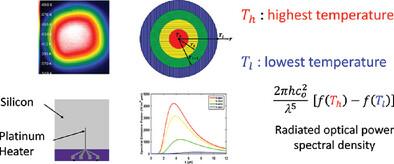当前位置:
X-MOL 学术
›
Adv. Electron. Mater.
›
论文详情
Our official English website, www.x-mol.net, welcomes your
feedback! (Note: you will need to create a separate account there.)
Effect of Inhomogeneous Temperature in Chip‐Scale Infrared Thermal Sources: A Revisited Blackbody Radiation Formula with Experimental Validation
Advanced Electronic Materials ( IF 5.3 ) Pub Date : 2024-11-20 , DOI: 10.1002/aelm.202400674 Shady R. Labib, Yasser M. Sabry, Ahmed. A. Elsayed, Frédéric Marty, Tarik Bourouina, Diaa Khalil
Advanced Electronic Materials ( IF 5.3 ) Pub Date : 2024-11-20 , DOI: 10.1002/aelm.202400674 Shady R. Labib, Yasser M. Sabry, Ahmed. A. Elsayed, Frédéric Marty, Tarik Bourouina, Diaa Khalil

|
Miniature and low‐cost light sources are highly desirable for numerous optical microsystems. Among these, devices based on blackbody radiation of a filament heated at a few hundred degrees, perfectly fit with the requirements of producing a broad spectral range falling in the infrared range, owing to Planck's law. These light sources are of primary interest for Fourier transform infrared (FTIR) spectroscopy. Although thermal light production is simple, achieving precise light intensity is not a trivial task. Herein, the impact of the inhomogeneous temperature on the emitted radiation is studied. Blackbody radiation formulae are revisited for miniature sources, taking into account the temperature distribution and using the principle of superposition of non‐coherent sources. A theoretical model is formulated by dividing the source into multiple annular elementary sources of different temperature. This results in effective, corrected blackbody emission. Analytical formulae are derived in the case of a quadratic temperature distribution. For the experimental validation, a silicon‐based source, made of a platinum resistive micro‐heater on top of heavily doped silicon, is fabricated and experimentally characterized at temperatures ranging from 300 to 520 K. The experimental results show good agreement with the model predictions in the explored wavelength range of (λ = 2.5–4.8 µm).
中文翻译:

芯片级红外热源中不均匀温度的影响:经过实验验证的重新审视的黑体辐射公式
微型和低成本光源是许多光学微系统非常理想的选择。其中,由于普朗克定律,基于加热几百度的细丝的黑体辐射的设备,完全符合在红外范围内产生宽光谱范围的要求。这些光源是傅里叶变换红外 (FTIR) 光谱的主要关注点。虽然热光产生很简单,但实现精确的光强度并非易事。本文研究了不均匀温度对发射辐射的影响。考虑到温度分布并使用非相干源叠加原理,重新审视了微型光源的黑体辐射公式。通过将源划分为多个不同温度的环形基本源来制定理论模型。这会产生有效的、校正的黑体发射。解析公式是在二次温度分布的情况下推导出的。为了进行实验验证,制造了一个由铂电阻式微加热器在重掺杂硅上制成的硅基光源,并在 300 至 520 K 的温度范围内进行了实验表征。实验结果表明,在探索的波长范围内 (λ = 2.5–4.8 μm) 与模型预测具有良好的一致性。
更新日期:2024-11-20
中文翻译:

芯片级红外热源中不均匀温度的影响:经过实验验证的重新审视的黑体辐射公式
微型和低成本光源是许多光学微系统非常理想的选择。其中,由于普朗克定律,基于加热几百度的细丝的黑体辐射的设备,完全符合在红外范围内产生宽光谱范围的要求。这些光源是傅里叶变换红外 (FTIR) 光谱的主要关注点。虽然热光产生很简单,但实现精确的光强度并非易事。本文研究了不均匀温度对发射辐射的影响。考虑到温度分布并使用非相干源叠加原理,重新审视了微型光源的黑体辐射公式。通过将源划分为多个不同温度的环形基本源来制定理论模型。这会产生有效的、校正的黑体发射。解析公式是在二次温度分布的情况下推导出的。为了进行实验验证,制造了一个由铂电阻式微加热器在重掺杂硅上制成的硅基光源,并在 300 至 520 K 的温度范围内进行了实验表征。实验结果表明,在探索的波长范围内 (λ = 2.5–4.8 μm) 与模型预测具有良好的一致性。































 京公网安备 11010802027423号
京公网安备 11010802027423号